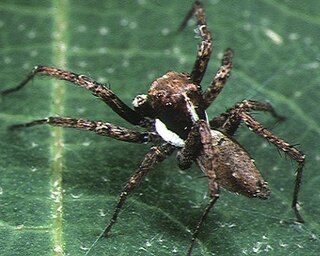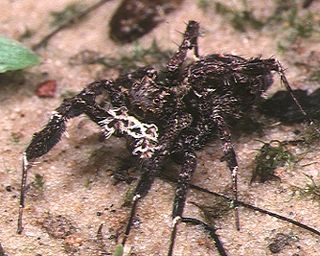
Jumping spiders are a group of spiders that constitute the family Salticidae. As of 2019, this family contained over 600 described genera and over 6,000 described species, making it the largest family of spiders at 13% of all species. Jumping spiders have some of the best vision among arthropods and use it in courtship, hunting, and navigation. Although they normally move unobtrusively and fairly slowly, most species are capable of very agile jumps, notably when hunting, but sometimes in response to sudden threats or crossing long gaps. Both their book lungs and tracheal system are well-developed, and they use both systems. Jumping spiders are generally recognized by their eye pattern. All jumping spiders have four pairs of eyes, with the anterior median pair being particularly large.

Portia is a genus of jumping spider that feeds on other spiders. They are remarkable for their intelligent hunting behaviour, which suggests that they are capable of learning and problem solving, traits normally attributed to much larger animals.

Neon is a spider genus of the jumping spider family, Salticidae. Its described species occur mostly in Eurasia, with some species found in North and South America. One species, N. convolutus, is also found in Algeria. Two species are known from Australia, N. australis and N. taylori. N. australis has palp morphology and fringing on its first pair of legs very similar to that seen in N. nojimai Ikeda 1995, from Japan. N. taylori is most similar in morphology to N. sumatranus from Indonesia and N. kovblyuki from the Crimea and elsewhere. The genus is common and widespread in litter throughout Australia, from the highlands of Tasmania through the hot, dry inland to the wet tropics and includes many undescribed species.
Wanlessia denticulata is a species of jumping spider.

Yaginumaella lobata is a jumping spider.
Zebraplatys bulbus is a species of jumping spider.
Cytaea levii is a species of jumping spider.
Tauala elongata is a species of jumping spider.
Chinophrys taiwanensis is a species of jumping spiders.

Hasarius adansoni, known commonly as Adanson's house jumper, is a species of jumping spider that is common in warm regions around the world, often associated with people.
Chinattus taiwanensis is a species of jumping spider found exclusively in Taiwan.
Pancorius taiwanensis is a species of jumping spiders found only in Taiwan. It is a tiny spider with a total length of only 2.25 millimetres (0.089 in). The densely hairy carapace is dark brown with a large pale, roughly triangular patch centrally. The legs are dark brown with large, prominent spines. The oval abdomen is grey with darker and lighter striations with paler patches on each side at the front.
Neon zonatus is a species of jumping spider found only in Taiwan. It is a tiny spider with a total length of only 2.25 mm. The carapace is greyish brown with a yellowish brown central area and a black margin. The whole carapace is densely covered with white hair. The legs are light brown with black patches and large, prominent spines. The wide abdomen is boldly striped black and light brown.
Spartaeus ellipticus is a species of jumping spiders found only in Taiwan. It has a total length of nearly 6 mm. The carapace is dark brown with paler markings towards the rear and a black margin. The whole carapace is densely covered with white hair. The legs are brown with many large, prominent spines. The oval abdomen is greyish brown marked overall with small dark patches.

Spiders are air-breathing arthropods that have eight legs, chelicerae with fangs generally able to inject venom, and spinnerets that extrude silk. They are the largest order of arachnids and rank seventh in total species diversity among all orders of organisms. Spiders are found worldwide on every continent except for Antarctica, and have become established in nearly every land habitat. As of November 2023, 51,673 spider species in 136 families have been recorded by taxonomists. However, there has been debate among scientists about how families should be classified, with over 20 different classifications proposed since 1900.

Portia fimbriata, sometimes called the fringed jumping spider, is a jumping spider found in Australia and Southeast Asia. Adult females have bodies 6.8 to 10.5 millimetres long, while those of adult males are 5.2 to 6.5 millimetres long. Both sexes have a generally dark brown carapace, reddish brown chelicerae ("fangs"), a brown underside, dark brown palps with white hairs, and dark brown abdomens with white spots on the upper side. Both sexes have fine, faint markings and soft fringes of hair, and the legs are spindly and fringed. However, specimens from New Guinea and Indonesia have orange-brown carapaces and yellowish abdomens. In all species of the genus Portia, the abdomen distends when the spider is well fed or producing eggs.

Wanda Wesołowska is a Polish zoologist known for her work with jumping spiders. She has described more species of jumping spider than any contemporary writer, and is second only to Eugène Simon in the history of arachnology. Originally a student of ornithology, she developed an interest in jumping spiders while still a student at the Siedlce University of Natural Sciences and Humanities in the 1970s.
Chinophrys is a genus of jumping spiders that was first described by J. X. Zhang & Wayne Paul Maddison in 2012.

Phintelloides is a genus of Asian jumping spiders erected by N. Kanesharatnam and Benjamin in 2019 after a molecular phylogenetic study of similar Asian Salticidae species. The single most likely cladogram shows that Phintelloides is sister to Phintella, with Proszynskia sister to both:

Cosmophasis lami, also known as the Lami Beach northern jumping spider or tangerine garden jumper, is a species of jumping spider in the genus Cosmophasis, probably native to South East Asia and some pacific islands, and possibly introduced to Japan and Okinawa Islands by humans. It was first described by Berry, Beatty & Prószynski in 1997 and has one synonym, Cosmophasis squamata (Saaristo,2002) Both the female and the male have been described.









